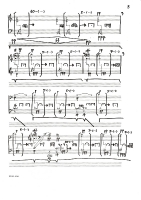Sonant for piano (1965/67)
The work is extremely important owing to its pioneering nature and strong influence on Sikorski’s later works. It contains new, original ideas, some of which were developed in a very interesting manner already in subsequent works, while others had to wait more than ten years to become fully formed. Sonant is also the first work in which Sikorski created a feeling of “time coming to a standstill” and so radically limited the musical material used.
It is also here that for the first time he followed the idea of transforming short modules, the idea that reached its crowning moment in Hymnos (1979). In Sonant, composed in 1965 and premiered in 1967 at the Warsaw Autumn, dynamic, harmonic and, above all, expressive transformations are applied to a short two-element pattern consisting of chords (or single notes) of the right and left hand directly following one another. However, the composer does not focus only on the transformations, but also on the qualities associated with the nature of notes, qualities like attack and sustain. An important role is also played by silence, which becomes the third quality, as if derived from the sustain component.
As Tomasz Sikorski wrote in the Warsaw Autumn programme booklet,
Sonant for piano solo was written in 1965. It is a piece based on a contrast between note attack and note sustain. The structure of the work, primarily its organisation in time (fermatas, approximate values depending each time on the sonic quality of the piano), as well as the “form” (stability, repeatability of structures etc.) are all consequences of a break-up of the sound matter of Sonant into two layers: attack and sustain.
This uncompromising piece must have caused a big stir and consternation among the listeners, a fact evidenced by Ludwik Erhardt’s opinion:
Not for the first time do I feel that Sikorski falls victim to his own sonic oversensitivity, which makes him indifferent to time and form. Who has never listened to dying sound, to piano sound box resonance fading away? In fact, Debussy did it already, though in a more interesting manner. This persistent monotony makes one long for some lively musical action.





